#Transformers Generations Legacy United Voyager Class
Explore tagged Tumblr posts
Text

Now our last figure/collectable that I received for Christmas is our final "Christmas Prime" the Transformers Legacy United Voyager Class Animated Universe Optimus Prime I was super excited to get him and was one of the ones I was looking for. I have the original one from the show and I wanted this one too. So I was totally happy when I unwrapped him
#christmas2024#xmas2024#ShannonJ286#NaughtyGirl286#Transformers#Transformers Generations Legacy#Transformers Legacy#Transformers Legacy United#autobots#action figures#hasbro#hasbro toys#Transformers Generations Legacy Voyager Class#Transformers Generations Legacy United Voyager Class#Optimus Prime#Transformers Generations#Voyager Class figures#Transformers Generations Legacy Voyager#Transformers Legacy United Voyager Animated Universe Optimus Prime#Transformers Generations Legacy Voyager Class Optimus Prime#Animated Universe Optimus Prime#Transformers Animated
22 notes
·
View notes
Text
New review is up on Youtube of a neat toy with the quaint and humble little name of Transformers Generations Legacy United Voyager Class Animated Universe Optimus Prime
youtube
11 notes
·
View notes
Text
STARSCREAM ( Voyager ) Generations LEGACY UNITED Cybertron

C'era un volta la miniserie a fumetti War Within della DreamWave, dove tramite le magiche matite di Don Figueroa i classici personaggi dei Transformers G1 venivano ritratti per la prima volta con fighissime forme Cybertroniane, e tutti bramavamo di vedere prima o poi quei meravigliosi design tramutati in modellini. E venne presto il giorno, dato che per la versione di Galaxy Force / Cybertron di STARSCREAM, Hasbro e Takara si ispirarono platealmente al seeker grigio e rosso visto nel fumetto succitato!
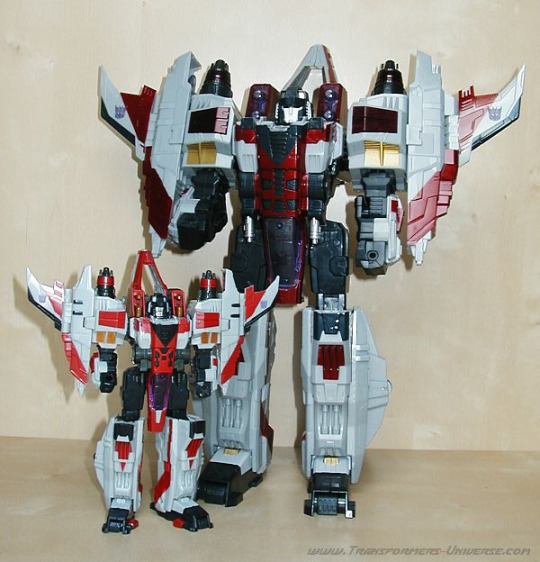
Tutto bene quindi? Circa, poiché ai tempi Hasbro decise di farne una versione gigante Supreme di questo Astrum, snobbando il Voyager uscito normalmente in Giappone, da qui la difficoltà ai tempi di trovare la versione più economica tramite mercato estero piuttosto che non comodamente nei negozi di giocattoli e ipermercati vari come ancora si usava ai tempi.

Già personalmente adoravo l'originale, figurarsi ora dopo quasi 20 anni, ritrovarselo in una versione Generations per Legacy United, una versione che è pure il paradigma di come dovrebbero essere questi aggiornamenti moderni di classici del passato, senza magari scadere in errori o pigrizie tecniche varie ( Hot Shot, sto parlando con te!! )

Il ROBOT esteticamente infatti è semplicemente splendido, dato che che potrebbe passare tranquillamente per una Action Figure non trasformabile da quanto è armonioso nelle forme e misure. E la cosa risalta ulteriormente appena tirato fuori dalla scatola, dato che i moduli alati che finiranno sulle spalle e gli alettoni sono appunto staccati, e si assemblano sulla figura grazie ai soliti fori per armi standard appositi.

I moduli alati sulle braccia davano al robot originale un che di maestoso, quasi avesse un mantello che gli scendeva sulle spalle, mentre il Legacy odierno è più agile e longilineo, con spalle meno imponenti ma di riflesso con avambracci normali e non tozzi come il GF.

Ma il tocco di classe che da alla figura quel qualcosa in più è certamente la parte centrale del jet che non scende con la punta fino alle ginocchia ma si ferma al pube, e la cabina in plastica trasparente ora non più ad altezza "pacco" ma sullo stomaco come i più classici dei Seeker.

Magari qualche dettaglio colorato latita come il giallo sulle spalle o un po' di rosso su gambe ed avambracci, ma la scultura è eccellente, ed è davvero alto come Voyager, ben una testa più del suo precedente omonimo Armada di Legacy, e vale quindi lo stesso discorso fatto per Hot Shot sull'evoluzione dei personaggi nelle varie fasi della trilogia.

Notevole come il bacino possa ruotare nonostante la parte centrale del jet copre tutto il torso fino al pube, ed abbia pure i pugni che ruotano, e nonostante l'ampio uso di massa per accessori ed altezza, non abbia vuoti come nei soliti posti fastidiosi come interno dei polsi, cosce e polpacci vari.

E parlando di accessori, ribadiamo che i moduli sulle braccia non solo hanno le ali che si piegano, ma come per la gimmick dell'originale, vi sono ripiegate all'interno ciascuno una lama in plastica viola trasparente, così come dello stesso materiale è la CYBER PLANET KEY ed il fucile che cita quello sparante del Voyager G.F.: quello originale era un rettangolone nero un po' anonimo col missile viola trasparente, questo invece ha un design più ricercato con un paio di alette qua e là, ed è esso stesso tutto viola trasparente!

Ma di bello il fucile ha che tramite un apposita fessura posteriore vi si può sistemare la C.P.K., oltre che nella fessura apposita sotto la nuca. Ah, infine, a proposito della schiena del nostro Astrum Cybertron, i due alettoni posteriori possono ripiegarsi al massimo verso il basso, dando così meno fastidio possibile rispetto invece a come un po' rimanevano più larghi del giocattolo Voyager del 2005.

La TRASFORMAZIONE è, come ovvio, molto simile all'originale ma con qualche tocco in più, ovvero le braccia che si ribaltano all'indietro ma non prima qui di aver ruotato di 180° ed aver fatto rientrare i pugni, un pannello poi che dietro la schiena si apre per nascondervi la testa, e le gambe che ruotano verso l'esterno e si ripiegano mentre si solleva il torso, ma con i pannelli dei polpacci che si aprono. Ed infine gli alettoni posteriori che si uniscono nella pinna

IL JET SPAZIALE è sputato all'originale come aspetto, a parte magari la zona della cabina di pilotaggio meno in rilievo, o le strisce rosse ai lati di queste ( cioè quindi sulle gambe ), così come le ali sarebbero un po' piccole ma non ci si fa caso se non con un confronto diretto col G.F. di un tempo, dato che per la fisionomia ed aerodinamicità del velivolo sono della giusta misura.

Anzi, ironico come senza i moduli alati e gli alettoni, e con la punta ripiegata, questo jet ricordi parecchio l'hovercraft spaziale di Scourge G1! :D

Comunque, tutti i dettagli dall'originale sono al loro posto, pure un modulo nero dietro la cabina a mimare la testa del robot che era nascosta alla buona! XD

Visto da sotto non è male, anche se ha i due pannelli dei polpacci uniti come fossero un modulo di entrata d'aria per il reattori, ma forse era meglio se lo rendevano comunque più aerodinamico. Di contro, il fucile può sistemarsi lì sotto semi nascosto come nel Cybertron o anche nell'alettone verticale, ed il jet ha ( a parte quelli per i moduli alati ) solo un paio di fori sotto per eventuali armi aggiuntive.

Insomma, un ottimo modello con una bella trasformazione, un robot strepitoso ed un gran bel jet col solo inestetismo della "presa d'aria" sotto il muso, ma per il resto finalmente un Generations praticamente perfetto, fedele e che migliora il già bello e carismatico giocattolo originale!

-Videorecensione
#transformers#hasbro#generations#decepticon#recensione#review#starscream#astrum#cybertron#galaxy force#legacy united#voyager#distructor#takara
4 notes
·
View notes
Text
Ten Interesting Vietnamese Novels
Paradise of the Blind by Duong Thu Huong
Paradise of the Blind is an exquisite portrait of three Vietnamese women struggling to survive in a society where subservience to men is expected and Communist corruption crushes every dream. Through the eyes of Hang, a young woman in her twenties who has grown up amidst the slums and intermittent beauty of Hanoi, we come to know the tragedy of her family as land reform rips apart their village. When her uncle Chinh‘s political loyalties replace family devotion, Hang is torn between her mother‘s appalling self–sacrifice and the bitterness of her aunt who can avenge but not forgive. Only by freeing herself from the past will Hang be able to find dignity and a future. - Goodreads
Ticket to Childhood by Nguyen Nhat Anh
The story of a man looking back on his life, Give Me a Ticket to Childhood captures the texture of childhood in all of its richness. As we learn of the small miracles and tragedies that made up the narrator’s life—the misadventures and the misdeeds—we meet his long-lost friends, none of whom can forget how rich their lives once were. And even if Nguyen Nhat Anh can’t take us back to our own childhoods, he captures those innocent times with a great deftness. -Goodreads
The Sympathizer by Viet Thanh Nguyen
It is April 1975, and Saigon is in chaos. At his villa, a general of the South Vietnamese army is drinking whiskey and, with the help of his trusted captain, drawing up a list of those who will be given passage aboard the last flights out of the country. The general and his compatriots start a new life in Los Angeles, unaware that one among their number, the captain, is secretly observing and reporting on the group to a higher-up in the Viet Cong. The Sympathizer is the story of this captain: a man brought up by an absent French father and a poor Vietnamese mother, a man who went to university in America, but returned to Vietnam to fight for the Communist cause. A gripping spy novel, an astute exploration of extreme politics, and a moving love story, The Sympathizer explores a life between two worlds and examines the legacy of the Vietnam War in literature, film, and the wars we fight today. - Goodreads
Dumb Luck by Vu Trong Phung
Banned in Vietnam until 1986, Dumb Luck is a bitter satire of the rage for modernization in Vietnam during the late colonial era. First published in Hanoi during 1936, it follows the absurd and unexpected rise within colonial society of a street-smart vagabond named Red-haired Xuan. As it charts Xuan's fantastic social ascent, the novel provides a panoramic view of late colonial urban social order, from the filthy sidewalks of Hanoi's old commercial quarter to the gaudy mansions of the emergent Francophile northern upper classes. The transformation of traditional Vietnamese class and gender relations triggered by the growth of colonial capitalism represents a major theme of the novel. Dumb Luck is the first translation of a major work by Vu Trong Phung, arguably the greatest Vietnamese writer of the twentieth century. The novel's clever plot, richly drawn characters and humorous tone and its preoccupation with sex, fashion and capitalism will appeal to a wide audience. It will appeal to students and scholars of Vietnam, comparative literature, colonial and postcolonial studies, and Southeast Asian civilization. - Goodreads
I Love Yous Are for White People by Lac Su
As a young child, Lac Su made a harrowing escape from the Communists in Vietnam. With a price on his father's head, Lac, with his family, was forced to immigrate in 1979 to seedy West Los Angeles where squalid living conditions and a cultural fabric that refused to thread them in effectively squashed their American Dream. Lac's search for love and acceptance amid poverty—not to mention the psychological turmoil created by a harsh and unrelenting father—turned his young life into a comedy of errors and led him to a dangerous gang experience that threatened to tear his life apart. - Goodreads
The Sorrow of War: A Novel of North Vietnam by Bao Ninh
Bao Ninh, a former North Vietnamese soldier, provides a strikingly honest look at how the Vietnam War forever changed his life, his country, and the people who live there. Originally published against government wishes in Vietnam because of its non-heroic, non-ideological tone, The Sorrow of War has won worldwide acclaim and become an international bestseller - Goodreads
Catfish and Mandala: A Two Wheeled Voyage Through the Landscape and Memory of Vietnam by Andrew X. Pham
Catfish and Mandala is the story of an American odyssey—a solo bicycle voyage around the Pacific Rim to Vietnam—made by a young Vietnamese-American man in pursuit of both his adopted homeland and his forsaken fatherland. Andrew X. Pham was born in Vietnam and raised in California. His father had been a POW of the Vietcong; his family came to America as "boat people." Following the suicide of his sister, Pham quit his job, sold all of his possessions, and embarked on a year-long bicycle journey that took him through the Mexican desert, around a thousand-mile loop from Narita to Kyoto in Japan; and, after five months and 2,357 miles, to Saigon, where he finds "nothing familiar in the bombed-out darkness." In Vietnam, he's taken for Japanese or Korean by his countrymen, except, of course, by his relatives, who doubt that as a Vietnamese he has the stamina to complete his journey ("Only Westerners can do it"); and in the United States he's considered anything but American. A vibrant, picaresque memoir written with narrative flair and an eye-opening sense of adventure, Catfish and Mandala is an unforgettable search for cultural identity. - Goodreads
The Best We Could Do by Thi Bui
This illustrated memoir is about the search for a better future and a longing for the past. Exploring the anguish of immigration and the lasting effects that displacement has on a child and her family, Bui documents the story of her family’s daring escape after the fall of South Vietnam in the 1970s, and the difficulties they faced building new lives for themselves. At the heart of Bui’s story is a universal struggle: While adjusting to life as a first-time mother, she ultimately discovers what it means to be a parent—the endless sacrifices, the unnoticed gestures, and the depths of unspoken love. Despite how impossible it seems to take on the simultaneous roles of both parent and child, Bui pushes through. - Goodreads
Ru by Kim Thuy
A runaway bestseller in Quebec, with foreign rights sold to 15 countries around the world, Kim Thúy's Governor General's Literary Award-winning Ru is a lullaby for Vietnam and a love letter to a new homeland. Ru. In Vietnamese it means lullaby; in French it is a small stream, but also signifies a flow - of tears, blood, money. Kim Thúy's Ru is literature at its most crystalline: the flow of a life on the tides of unrest and on to more peaceful waters. In vignettes of exquisite clarity, sharp observation and sly wit, we are carried along on an unforgettable journey from a palatial residence in Saigon to a crowded and muddy Malaysian refugee camp, and onward to a new life in Quebec. There, the young girl feels the embrace of a new community, and revels in the chance to be part of the American Dream. As an adult, the waters become rough again: now a mother of two sons, she must learn to shape her love around the younger boy's autism. Moving seamlessly from past to present, from history to memory and back again, Ru is a book that celebrates life in all its wonder: its moments of beauty and sensuality, brutality and sorrow, comfort and comedy. -Goodreads
The Refugees by Viet Thanh Nguyen
From a young Vietnamese refugee who suffers profound culture shock when he comes to live with two gay men in San Francisco, to a woman whose husband is suffering from dementia and starts to confuse her for a former lover, to a girl living in Ho Chi Minh City whose older half-sister comes back from America having seemingly accomplished everything she never will, the stories are a captivating testament to the dreams and hardships of immigration. -Goodreads
5 notes
·
View notes
Link
Since the 2016 election, national media outlets have been on a constant expedition in pursuit of that most elusive of specimens: Any of the nearly 63 million Americans who voted for Donald Trump. Braving such far-flung locales as Staten Island, reporters have sought evidence that Republican voters indeed voted for a Republican president. So far, the consensus appears to be that electing Donald Trump required someone to like his politics enough to vote for him.
Many of the pieces searching for the reasons for Trump’s rise and stubborn popularity among GOP voters defy satire. These are boom times for maudlin amateur sociology. Anywhere that codes as “white” and/or “rural” must now be rediscovered as if it were a lost civilization once swallowed by the sands of Obergefell v. Hodges. Half the time, the takes are just wrong. As Alex Nichols writes, pickup trucks, a cherished symbol of country life to urban media commentators, are in fact expensive and a staple of the white upper-middle-class: “Anyone with roots in the suburbs can testify that many a cul-de-sac is now lined with beefed-up Rams and Silverados used solely to commute to air-conditioned office jobs. What out-of-touch columnists consider bona-fide symbols of working-class authenticity are often just the hallmarks of well-off white suburbanites.”
Well-off white suburbanites are Trump’s true base, as they’ve been the base of every Republican president since at least Nixon. That the Republican Party has loyal voters and can rally them for even a controversial candidate appears to be a truth that eludes New York Times columnists. Still, talking to some Trump voters might indeed yield insights. The broad left-of-center may or may not be taking the right lessons from voters who went from Obama to Trump, for example, but it’s worth asking why they did.
Yet the most compelling anecdotes about the election have come from reporting about those who didn’t turn out at all. More than eight months after its publication, a New York Times story titled “Many in a Milwaukee Neighborhood Didn’t Vote—and Don’t Regret It” might still be the best source of searing quotes about the Hillary Clinton campaign’s failures in key Rust Belt states. It’s hard to argue when a barber who twice voted for Obama and has struggled to find workable health insurance pairs his declaration that he didn’t vote with the line, “Ain’t none of this been working.” Maybe someone should ask him what he thinks would work.
Or we could ask why a dude in rural California is looking soulfully out his window.
“California’s Far North Deplores ‘Tyranny’ of the Urban Majority” leads with a baleful photo of a megachurch pastor in the shadow of three stuffed deer heads, helpfully captioned, “Eric Johnson at Bethel Church in Redding, Calif., not the California of ‘Baywatch’ fame.” The piece goes on to cite a movement to establish a breakaway state called Jefferson and the vague grievances of a retired pilot who can afford what appears to be a hobby ranch full of horses and bison. Halfway through, we get this stunning line: “But perhaps nowhere else in California is the alienation felt more keenly than in the far north, an arresting panorama of fields filled with wildflowers and depopulated one-street towns that have never recovered from the gold rush.” The biggest California gold rush ended in 1855. If Trump wins a second term, maybe reporters will get around to asking Atlanta residents whether anything has changed since their city was burned down by General Sherman.
In a recent issue of The New Yorker, red voters in a blue state get the longform treatment. Peter Hessler reports from Grand Junction, Colorado, a boom-and-bust energy industry city on the far side of the mountains from the thriving Denver area. The headline reads, “How Trump is Transforming Rural America.” Even though Hessler is as circumspect and shy of caricature as you’d expect from a writer who’s done incisive dispatches about places as different as China, Egypt, and the United Kingdom, we know from the get-go that this will be a voyage of discovery. It’s not enough for Trump to make sense within existing partisan logic; he must be the harbinger of something new and angry.
Hessler paints a picture of an energized local GOP base that embraced Trump’s irreverence and sense of grievance. Western Slope Trump supporters even replicated the candidate’s sparring with the media in a battle with the local paper that got national attention. The piece opens with a portrait of Karen Kulp, a nurse who grew up as a doomsday Bircher, then became culturally more liberal, and finally became a political activist in the 2016 election. The punch line is that she helped found a local group of Trump supporters, despite a narrative arc that bore all the hallmarks of a Boomer Clintonista. Hessler’s opening gambit is to defy expectation while still landing us back in the headspace of the Trump Voter.
Grand Junction perfectly fits the established Trumpville profile. Legacy reliance on a declining industry (oil and natural gas extraction), a predominantly white population, cultural conservatism, blue-collar self-image, an apparent sense of grievance and betrayal at the prosperity, snobbery, and statewide political power of a wealthier urban populace not very far away in Denver and Boulder. Crime is up and schools are in trouble. Hessler sets out to chart the ways in which the political currents of Grand Junction dovetail with the real and imagined landscape of diehard Trump supporters throughout the country. It makes sense that he’d focus mostly on activists and local party operatives. If the thesis is that Trumpism represents a distinctive, transformative movement, the people driving it on the ground in a place like Grand Junction are the ones creating change.
Matt Patterson gets more ink in Hessler’s piece than anyone. A working-class Grand Junction boy by birth, Patterson dropped out of high school, became a successful magician, and then studied classics at Columbia after a car accident destroyed his magic career. He has since worked for conservative nonprofits, with a special focus on anti-union activism. Though he now lives in D.C., he spent the election in Grand Junction organizing for Trump. Patterson comes across as a charismatic shape-shifter: “[At] times he dresses with the flair of a goth: black T-shirt, leather bracelet studded with skulls, silver ring decorated with a flying bat. Sometimes he paints his fingernails black. These accessories vanish when it’s time to interact with factory workers, voters, or Republicans in Middle America.” Hessler’s descriptions of Patterson fit with the essay’s basic strategies to avoid falling into the bald clichés of most Trump Voter pieces: Elaborate apparent contradictions, emphasize that “I learned to suspend any customary assumptions regarding political identity,” and then note that you met a “hippieish” guy with a ponytail who voted for Trump.
Patterson’s importance to the piece is that he was an early Trump supporter who happens to be from Grand Junction and worked there during the campaign. It doesn’t at all follow that his existence demonstrates that Trump is “transforming” much of anything. Patterson is a slick Ivy League alumnus who has worked with Grover Norquist. We have a term for people like Matt Patterson: party hacks. And everywhere party hacks go, they cultivate eager local volunteers like Karen Kulp. If Trump innovated anything in Grand Junction, it was getting his volunteers to pay him for the privilege of helping out. As Kulp memorably says of the Inauguration Day “DeploraBall” she helped organize, “Every shirt you see here tonight, I bought.” This is the only genuinely impressive feat of political salesmanship recorded in Hessler’s piece.
A necessary conceit of the Trump Voter piece is that it must be interesting that someone voted for Trump. Was it interesting when people voted for Mitt Romney or Gerald Ford? Was it a metaphor for the tragedies of hardscrabble white America? No, presumably because those guys are a lot duller than Trump. No argument there. But the boring fact underlying Trump’s victory and now his presidency is that he’s a servant of very familiar forces.
The GOP agenda under Trump is basically what it would have been under Marco Rubio or Jeb Bush, only with more chaotic news cycles and instantly lower approval ratings. The Matt Pattersons of the world didn’t create this reality—that would be the Charles Kochs and Sheldon Adelsons—but they do know how to keep it going. One way to keep the oligarchic agenda humming along is to give it an aesthetic of rugged authenticity. Trump does that very well, and he gets a lot of media help. It may be impossible to write a Trump Voter piece, however careful, that doesn’t end up doing the work of making age-old robber baron politics look like an Andrew Wyeth painting come to life. We should probably stop trying.
There are lots of worthwhile things we could learn about life in Redding, California or rural Colorado or anywhere else with especially reactionary politics. Everyone quoted in Hessler’s piece had something to say about their home. The frustrating thing about Trump Voter pieces is not that they reduce whole regions to politics; it’s that they reduce those politics to Trump. If voting for Trump was such a convulsive act in Grand Junction, then is it also true that if Hillary Clinton were president, life there would be noticeably different? Trump Voter pieces mostly don’t seem interested in that kind of question. There might be hand-waves at NAFTA and industrial decay and opiates and wealth being sucked into big cities. Why is any of that happening? Who benefits? Can we do anything about it? I guess we could look ruefully out our windows at the world we share with Trump Voters.
71 notes
·
View notes
Text
Farewell to the 747, the Plane That Shrank the World
For a half-century, Boeing Co. mechanics in a sprawling factory north of Seattle have riveted together aluminum panels into the familiar hump-backed form of the 747 jumbo jet. Test pilots then put each new plane through its paces on an adjacent air strip before sending it off to roam the globe.
This airplane, more than any other, made long-range travel into a mass-market phenomenon. And on Monday, one of the jets born here returned home.
Delta Air Lines Inc. flew a 747 filled with employees and customers from its Detroit hub to Boeing’s plant in Everett, Washington. It was the first in a series of farewell flights to Delta hubs this week, marking the end of the airliner’s U.S. passenger service. For those aboard, it was a rare opportunity to touch down on the same runway from which the first 747 lifted skyward on Feb. 9, 1969.
On the ground, Boeing workers who helped build 747-400s like the returning Delta plane celebrated an aviation milestone. But there’s poignancy to the moment: With just 14 unfilled orders in Boeing’s backlog, four-engine aircraft appears to have fallen out of favor. The future isn’t bright for jumbo jetliners such as the old 747.
For a morning, at least, Delta and Boeing set aside their differences to bask in nostalgia. Just last week, Delta ordered 100 jets from Airbus SE, Boeing’s rival. And a trade fight between the U.S. jetmaker and Bombardier Inc. threatens to foul up a separate deal that’s key to Delta’s fleet plans.
There were those aboard Monday’s farewell-to-passengers flight who came of age with the 747. The planes’ hulking wings—and, for children riding on Pan Am in the 1970s heyday, those captain’s wing pins—symbolized access for millions of us to foreign lands not easily reached by telephones of the era. A generation came to learn the aircraft’s quirks, such as the jet’s bulbous nose and swept wings and the vibrations during the take-off roll that caused over-stuffed luggage bins to pop open on early models. There was also the fascination, never lost for some, of ascending a staircase to ride high above the world in the “bubble,” the deck behind the cockpit.
Delta Flight 9771 rumbled down the runway and lifted into the air at 7:47 a.m. on Monday in Detroit, the first flight on a farewell tour this week, with stops planned at Delta strongholds in Seattle, Atlanta, Minneapolis and Los Angeles. The aircraft will ferry NFL and college football teams in late December before making a final ferry flight to the desert in January. To win a seat on Monday’s charter flight, Delta customers bid frequent flyer miles, while employees and retirees entered an internal lottery, with selection based in part on seniority and personal connection to the 747 fleet.
The celebration on board was low-key, more a reunion of old friends than the boisterous parties that sometimes mark commemorative flights. The four-and-a-half-hour journey provided many on board a chance to relive old times, especially for those who had plied trans-Pacific routes for Northwest Airlines prior to the merger. There was a throwback meal service—hot breakfast followed by a light lunch—and a 747-centric trivia quiz. (Sample question: How many miles of wiring are on a 747-400? Answer: 171.)
“I get all choked up,’’ said Christine L’Allier, who has spent most of her 32 years at Delta and Northwest as a flight attendant aboard the jumbos. She recalled Thanksgivings spent at 35,000 feet, with the traditional meal cooked in ovens large enough to fit a turkey. “When you were away from home, this was your family.”
The 747 was the first twin-aisle airplane, with more than double the capacity of the largest commercial craft at the time. Delta’s 747s, introduced on a maiden voyage in 1970 from Atlanta to Dallas to Los Angeles, brought the first overhead luggage bins to the airline, as well as the first in-flight audio channels, dubbed “Deltasonic,” which featured the Beatles, Burt Bacharach and Beethoven. The planes could hold 370 passengers, including 66 in first class and six in those penthouse seats up the stairs.
The design made it literally a wide-body, which became a moniker for long-range aircraft. “It’s one of two seminal airplanes,” said George Hamlin, an aerospace consultant, a former airline and aerospace executive and an aviation history buff. The DC-3, the other iconic aircraft on Hamlin’s list, was a silver piston-engine made by Douglas that helped airlines evolve from mail carriers to people movers in the 1930s and 1940s.
But it was the long-haul capability—a 6,000-mile reach—that made the 747 transformational. “The range of the plane allowed it to go anywhere in the world,” said Michael Lombardi, Boeing’s corporate historian. “It was at that point in history where all of humanity had the ability to get on a flight.”
The peak year of the 747 came in 2002, when the airplane completed 33,000 flights hauling 10.5 million passengers on 50 airlines. All told, 1,540 Boeing aircraft have been delivered since 1969.
“It was the plane that shrank the world. That is the legacy of the 747,” Lombardi said. “Joe Sutter would tell you the same thing.”
The farewell tour for the Delta 747 also serves as an elegy for Sutter, who died last year at 95. The blunt, sometimes fiery tempered Boeing engineer was known as the “Father of the 747” for his role in shepherding the plane to market in the 1960s against steep odds. Juan Trippe, the autocratic founder of Pan American World Airways who was then the most powerful person in aviation, wanted a single-aisle design with two decks. Sutter believed that the configuration would doom the big plane, so he held out for the single-deck, twin-aisle design. His team, nicknamed the “Incredibles,” brought the plane to life in less than two and a half years, while dealing with balky engines and the prospect of financial collapse.
Boeing created the plant in Everett—the largest building on the planet by volume—just to build the 747, and the same facility eventually turned out such wide-body successors as the 767, 777 and 787 Dreamliner. Airplane sales were already slumping by the time the 747 debuted in the turbulent 1970s travel market, but Lombardi said the period proved fertile for Boeing’s development of next-generation improvements: cockpits operated by two pilots instead of three, flight computers and glass screens to replace analog dials.
Monday’s event in Everett actually marked the second time Delta has retired its 747 fleet. The Atlanta-based carrier took delivery of the first of five 747-100s in October 1970, a period when U.S. carriers were starting to experiment with wide-body jets on domestic routes. The planes featured a Delta “penthouse” behind the upper deck that could be reserved by private parties or by five or six customers who purchased seats together. Even with features such as “deep carpet, soft lights, patina of rosewood and walnut, stereo sound,” as Delta described the private lounges in a brochure, the new planes struggled to make money and were eventually returned to Boeing.
The company eventually created the best-selling 747 model, the -400, which was delivered first to Northwest Airlines in 1989. This started the fleet that would eventually become Delta’s when the airlines merged nearly two decades later. Delta retired the prototype on Sept. 9, 2015, after it had logged 61 million miles.
Delta became the last U.S. carrier to fly the passenger version of the 747 once United Airlines retired its jumbo fleet in November. Outside of the U.S., however, there will still be plenty of 747s carrying passengers: British Airways, Korean Air Lines Co. and Deutsche Lufthansa AG are all big operators.
But over the past 10 years, sales of the latest Boeing 747 model have dwindled, and the jet’s future, to the extent that there is one, will be as a freighter, said George Ferguson, aerospace analyst with Bloomberg Intelligence. United Parcel Service Inc. holds all but three of the unfilled orders left for the 747, as well as options to order an additional 14 planes.
“It’s never going to be a big seller again, that’s absolutely done,” Ferguson said of the 747. “It can hang on for a while, but it’s a sunset.”
The post Farewell to the 747, the Plane That Shrank the World appeared first on Bloomberg Businessweek Middle East.
from WordPress http://ift.tt/2CZQxRV via IFTTT
0 notes
Text
Delta Takes the Iconic 747 Jumbo Jet on a Farewell Tour
Delta is taking its 747s on a farewell tour this week to mark the aircraft being retired from U.S. passenger service. Delta Air Lines
Skift Take: The death of the Boeing 747, which introduced long-haul air travel to the masses, has at times been exaggerated. While Delta will retire the jumbo jet in the U.S., British Airways, Korean Air and Lufthansa all continue to fly the plane.
— Dennis Schaal
For a half-century, Boeing Co. mechanics in a sprawling factory north of Seattle have riveted together aluminum panels into the familiar hump-backed form of the 747 jumbo jet. Test pilots then put each new plane through its paces on an adjacent air strip before sending it off to roam the globe.
This airplane, more than any other, made long-range travel into a mass-market phenomenon. And on Monday, one of the jets born here is returning home.
Delta Air Lines Inc. will fly a 747 filled with employees and customers from its Detroit hub to Boeing’s plant in Everett, Washington. It’s the first in a series of farewell flights to Delta hubs this week marking the end of the airliner’s U.S. passenger service. For those aboard, it’s a rare opportunity to touch down on the same runway from which the first 747 lifted skyward on Feb. 9, 1969.
On the ground, Boeing workers who helped build 747-400s like the returning Delta plane will celebrate an aviation milestone. But there’s poignancy to the moment: With just 14 unfilled orders in Boeing’s backlog, and four-engine aircraft appears to have fallen out of favor. The future isn’t bright for jumbo jetliners such as the old 747.
For a morning, at least, Delta and Boeing will be setting aside their differences to bask in nostalgia. Just last week, Delta ordered 100 jets from Airbus SE, Boeing’s rival. And a trade fight between the U.S. planemaker and Bombardier Inc. threatens to foul up a separate deal that’s key to Delta’s fleet plans.
There will be those aboard Monday’s farewell-to-passengers flight who came of age with the 747. The planes’ hulking wings—and, for children riding on Pan Am in the 1970s heyday, those captain’s wing pins—symbolized access for millions of us to foreign lands not easily reached by telephones of the era. A generation came to learn the aircraft’s quirks, such as the jet’s bulbous nose and swept wings and the vibrations during the take-off roll that caused over-stuffed luggage bins to pop open on early models. There was also the fascination, never lost for some, of ascending a staircase to ride high above the world in the “bubble,” the deck behind the cockpit.
The 747 was the first twin-aisle airplane, with more than double the capacity of the largest commercial craft at the time. Delta’s 747s, introduced on a maiden voyage in 1970 from Atlanta to Dallas to Los Angeles, brought the first overhead luggage bins to the airline, as well as the first in-flight audio channels, dubbed “Deltasonic,” which featured the Beatles, Burt Bacharach and Beethoven. The planes could hold 370 passengers, including 66 in first class and six in those penthouse seats up the stairs.
The design made it literally a wide-body, which became a moniker for long-range aircraft. “It’s one of two seminal airplanes,” said George Hamlin, an aerospace consultant, a former airline and aerospace executive and an aviation history buff. The DC-3, the other iconic aircraft on Hamlin’s list, was a silver piston-engine made by Douglas that helped airlines evolve from mail carriers to people movers in the 1930s and 1940s.
But it was the long-haul capability—a 6,000-mile reach—that made the 747 transformational. “The range of the plane allowed it to go anywhere in the world,” said Michael Lombardi, Boeing’s corporate historian. “It was at that point in history where all of humanity had the ability to get on a flight.”
The peak year of the 747 came in 2002, when the airplane completed 33,000 flights hauling 10.5 million passengers on 50 airlines. All told, 1,540 Boeing aircraft have been delivered since 1969.
“It was the plane that shrank the world. That is the legacy of the 747,” Lombardi said. “Joe Sutter would tell you the same thing.”
The farewell tour for the Delta 747 also serves as an elegy for Sutter, who died last year at 95. The blunt, sometimes fiery tempered Boeing engineer was known as the “Father of the 747” for his role in shepherding the plane to market in the 1960s against steep odds. Juan Trippe, the autocratic founder of Pan American World Airways who was then the most powerful person in aviation, wanted a single-aisle design with two decks. Sutter believed that the configuration would doom the big plane, so he held out for the single-deck, twin-aisle design. His team, nicknamed the “Incredibles,” brought the plane to life in less than two and a half years, while dealing with balky engines and the prospect of financial collapse.
Boeing created the plant in Everett—the largest building on the planet by volume—just to build the 747, and the same facility eventually turned out such wide-body successors as the 767, 777 and 787 Dreamliner. Airplane sales were already slumping by the time the 747 debuted in the turbulent 1970s travel market, but Lombardi said the period proved fertile for Boeing’s development of next-generation improvements: cockpits operated by two pilots instead of three, flight computers and glass screens to replace anode dials.
Monday’s event in Everett actually marks the second time Delta has retired its 747 fleet. The Atlanta-based carrier took delivery of the first of five 747-100s in October 1970, a period when U.S. carriers were starting to experiment with wide-body jets on domestic routes. The planes featured a Delta “penthouse” behind the upper deck that could be reserved by private parties or by five or six customers who purchased seats together. Even with features such as “deep carpet, soft lights, patina of rosewood and walnut, stereo sound,” as Delta described the private lounges in a brochure, the new planes struggled to make money and were eventually returned to Boeing.
Boeing eventually created the best-selling 747 model, the -400, which was delivered first to Northwest Airlines in 1989. This started the fleet that would eventually become Delta’swhen the airlines merged nearly two decades later. Delta retired the prototype on Sept. 9, 2015, after it had logged 61 million miles.
Delta became the last U.S. carrier to fly the passenger version of the 747 once United Airlines retired its jumbo fleet in November. Outside of the U.S., however, there will still be plenty of 747s carrying passengers: British Airways, Korean Air and Lufthansa are all big operators.
But over the past 10 years, sales of the latest Boeing 747 model have dwindled, and the jet’s future, to the extent that there is one, will be as a freighter, said George Ferguson, aerospace analyst with Bloomberg Intelligence. United Parcel Service Inc. holds all but three of the unfilled orders left for the 747, as well as options to order an additional 14 planes.
“It’s never going to be a big seller again, that’s absolutely done,” Ferguson said of the 747. “It can hang on for a while, but it’s a sunset.”
To contact the author of this story: Julie Johnsson in Chicago at [email protected].
To contact the editor responsible for this story: Aaron Rutkoff at [email protected].
©2017 Bloomberg L.P.
This article was written by Julie Johnsson from Bloomberg and was legally licensed through the NewsCred publisher network. Please direct all licensing questions to [email protected].
0 notes
Text
Delta Takes the Iconic 747 Jumbo Jet on a Farewell Tour
Delta is taking its 747s on a farewell tour this week to mark the aircraft being retired from U.S. passenger service. Delta Air Lines
Skift Take: The death of the Boeing 747, which introduced long-haul air travel to the masses, has at times been exaggerated. While Delta will retire the jumbo jet in the U.S., British Airways, Korean Air and Lufthansa all continue to fly the plane.
— Dennis Schaal
For a half-century, Boeing Co. mechanics in a sprawling factory north of Seattle have riveted together aluminum panels into the familiar hump-backed form of the 747 jumbo jet. Test pilots then put each new plane through its paces on an adjacent air strip before sending it off to roam the globe.
This airplane, more than any other, made long-range travel into a mass-market phenomenon. And on Monday, one of the jets born here is returning home.
Delta Air Lines Inc. will fly a 747 filled with employees and customers from its Detroit hub to Boeing’s plant in Everett, Washington. It’s the first in a series of farewell flights to Delta hubs this week marking the end of the airliner’s U.S. passenger service. For those aboard, it’s a rare opportunity to touch down on the same runway from which the first 747 lifted skyward on Feb. 9, 1969.
On the ground, Boeing workers who helped build 747-400s like the returning Delta plane will celebrate an aviation milestone. But there’s poignancy to the moment: With just 14 unfilled orders in Boeing’s backlog, and four-engine aircraft appears to have fallen out of favor. The future isn’t bright for jumbo jetliners such as the old 747.
For a morning, at least, Delta and Boeing will be setting aside their differences to bask in nostalgia. Just last week, Delta ordered 100 jets from Airbus SE, Boeing’s rival. And a trade fight between the U.S. planemaker and Bombardier Inc. threatens to foul up a separate deal that’s key to Delta’s fleet plans.
There will be those aboard Monday’s farewell-to-passengers flight who came of age with the 747. The planes’ hulking wings—and, for children riding on Pan Am in the 1970s heyday, those captain’s wing pins—symbolized access for millions of us to foreign lands not easily reached by telephones of the era. A generation came to learn the aircraft’s quirks, such as the jet’s bulbous nose and swept wings and the vibrations during the take-off roll that caused over-stuffed luggage bins to pop open on early models. There was also the fascination, never lost for some, of ascending a staircase to ride high above the world in the “bubble,” the deck behind the cockpit.
The 747 was the first twin-aisle airplane, with more than double the capacity of the largest commercial craft at the time. Delta’s 747s, introduced on a maiden voyage in 1970 from Atlanta to Dallas to Los Angeles, brought the first overhead luggage bins to the airline, as well as the first in-flight audio channels, dubbed “Deltasonic,” which featured the Beatles, Burt Bacharach and Beethoven. The planes could hold 370 passengers, including 66 in first class and six in those penthouse seats up the stairs.
The design made it literally a wide-body, which became a moniker for long-range aircraft. “It’s one of two seminal airplanes,” said George Hamlin, an aerospace consultant, a former airline and aerospace executive and an aviation history buff. The DC-3, the other iconic aircraft on Hamlin’s list, was a silver piston-engine made by Douglas that helped airlines evolve from mail carriers to people movers in the 1930s and 1940s.
But it was the long-haul capability—a 6,000-mile reach—that made the 747 transformational. “The range of the plane allowed it to go anywhere in the world,” said Michael Lombardi, Boeing’s corporate historian. “It was at that point in history where all of humanity had the ability to get on a flight.”
The peak year of the 747 came in 2002, when the airplane completed 33,000 flights hauling 10.5 million passengers on 50 airlines. All told, 1,540 Boeing aircraft have been delivered since 1969.
“It was the plane that shrank the world. That is the legacy of the 747,” Lombardi said. “Joe Sutter would tell you the same thing.”
The farewell tour for the Delta 747 also serves as an elegy for Sutter, who died last year at 95. The blunt, sometimes fiery tempered Boeing engineer was known as the “Father of the 747” for his role in shepherding the plane to market in the 1960s against steep odds. Juan Trippe, the autocratic founder of Pan American World Airways who was then the most powerful person in aviation, wanted a single-aisle design with two decks. Sutter believed that the configuration would doom the big plane, so he held out for the single-deck, twin-aisle design. His team, nicknamed the “Incredibles,” brought the plane to life in less than two and a half years, while dealing with balky engines and the prospect of financial collapse.
Boeing created the plant in Everett—the largest building on the planet by volume—just to build the 747, and the same facility eventually turned out such wide-body successors as the 767, 777 and 787 Dreamliner. Airplane sales were already slumping by the time the 747 debuted in the turbulent 1970s travel market, but Lombardi said the period proved fertile for Boeing’s development of next-generation improvements: cockpits operated by two pilots instead of three, flight computers and glass screens to replace anode dials.
Monday’s event in Everett actually marks the second time Delta has retired its 747 fleet. The Atlanta-based carrier took delivery of the first of five 747-100s in October 1970, a period when U.S. carriers were starting to experiment with wide-body jets on domestic routes. The planes featured a Delta “penthouse” behind the upper deck that could be reserved by private parties or by five or six customers who purchased seats together. Even with features such as “deep carpet, soft lights, patina of rosewood and walnut, stereo sound,” as Delta described the private lounges in a brochure, the new planes struggled to make money and were eventually returned to Boeing.
Boeing eventually created the best-selling 747 model, the -400, which was delivered first to Northwest Airlines in 1989. This started the fleet that would eventually become Delta’swhen the airlines merged nearly two decades later. Delta retired the prototype on Sept. 9, 2015, after it had logged 61 million miles.
Delta became the last U.S. carrier to fly the passenger version of the 747 once United Airlines retired its jumbo fleet in November. Outside of the U.S., however, there will still be plenty of 747s carrying passengers: British Airways, Korean Air and Lufthansa are all big operators.
But over the past 10 years, sales of the latest Boeing 747 model have dwindled, and the jet’s future, to the extent that there is one, will be as a freighter, said George Ferguson, aerospace analyst with Bloomberg Intelligence. United Parcel Service Inc. holds all but three of the unfilled orders left for the 747, as well as options to order an additional 14 planes.
“It’s never going to be a big seller again, that’s absolutely done,” Ferguson said of the 747. “It can hang on for a while, but it’s a sunset.”
To contact the author of this story: Julie Johnsson in Chicago at [email protected].
To contact the editor responsible for this story: Aaron Rutkoff at [email protected].
©2017 Bloomberg L.P.
This article was written by Julie Johnsson from Bloomberg and was legally licensed through the NewsCred publisher network. Please direct all licensing questions to [email protected].
0 notes
Text
BMW M5 2016
No other super cantina offers the BMW M5's mix of mind-twisting straight-line execution, dynamic capacity and ordinary ease of use. Some will grieve the loss of the past M5's hyper V10, however the new 4.4-liter twin-turbo V8 returns significantly more execution and uses less fuel. The F10 era's double grip gearbox is a boundless change over the old auto's SMG 'box, as well.
This M5 is an out and out more refined machine than the E60 rendition, however despite everything it brags class-driving progression and a level of nimbleness that sits totally inconsistent with the close to two-ton kerb weight. While the present era M3 and M4 models are not as much as persuading in their dynamic make-up, the M5 is consummately judged.
The limited, yet nice looking outside styling and wonderfully designated lodge basically entire the bundle. This M5 is a high water stamp both for BMW and for the super cantina in general.
BMW M5 costs commence at £73,985 - that is with no alternatives included, however the auto comes liberally prepared as standard. Essentially every significant alternative you would tick on a standard 5-arrangement is available and represented - 19-inch M lightweight combination wheels, atmosphere control, voyage control, versatile LED headlights and expanded Merino calfskin upholstery.
On the off chance that you favor transforming your super-cantina into an extravagance auto, you can include choices like a back seat stimulation pack and the wonderful M multifunction seats (£835 as an alternative).
On the other hand, you could take the another course and update the auto's execution. The Competition Package comes in at £6700 and includes a power help in addition to overhauled suspension, while M carbon artistic brakes cost £7395.
The 30 Jahre show, restricted to only 300 units around the world, was at a bargain quickly for £91,890. That is a critical premium over the standard model, however the lodge comes perfectly selected with swathes of Alcantara and it has the selectiveness figure on its side, as well.
It's not as large a premium as the new Competition Edition display however, which begins at £100,995. That is a genuine add up to pay, especially given the 30 Jahre gloated the same 592bhp power yield with little hardware punishment somewhere else. We'd be enticed rather to spend the distinction to get an appropriate cut of M5 legacy, since you can purchase any past era of M5 for not as much as the contrast between this model and the standard auto.
The M5 confronts stern rivalry in the state of the Mercedes E63 AMG, which is more than a match in execution terms, yet falls only somewhat short progressively. The Jaguar XFR-S is a characterful option, however it does not have the M5's dealing with clean, and keeping in mind that the Porsche Panamera GTS is practically the M5's equivalent as a driver's auto, it is still some path down on power. On the off chance that looking great is a need, an Audi RS7 (here tried against the Panamera GTS) is additionally justified regardless of a look, however it's not the driving machine a M5 is.
Eventually, the M5 is the super cantina of decision right now, yet with another E63 AMG in transit and Porsche uncovering its exceptionally most recent Panamera - which will likewise be accessible with an all-new turbocharged V8 - the maturing M5 may have some extreme rivalry staring its in the face. It's not hard to envision Jaguar in the long run assembling a SVR variant of the current XF either.
0 notes
Text
CHEETOR ( Core ) Generations LEGACY UNITED *Beast Machines*
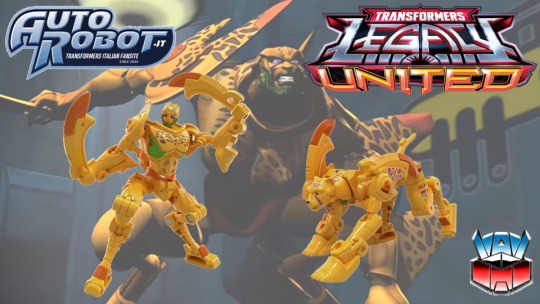
Nella trilogia Legacy hanno riproposto la qualsiasi a livello di personaggi di linee di Transformers spalmate nei 40 anni dell'esistenza del marchio, ma solo ora, solo con questo CHEETOR finalmente viene omaggiata anche Beast Machines… peccato che il nostro felino sia però un semplice classe Core! ^^'
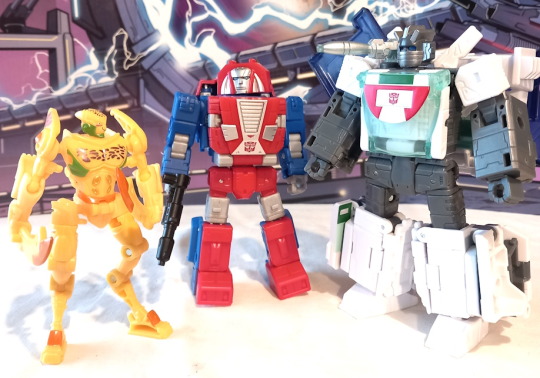
Perlomeno così, però, è l'unico Beast tizio ad essere in scala con i vari bot G1, praticamente, ed anzi, sta cosa di fare i Core Class dei BW proprio per raggiungere questo obiettivo mi aspettavo che la facessero prima!
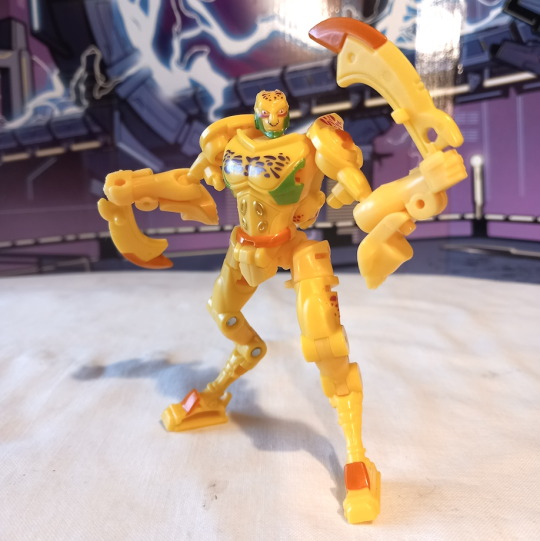
Per quanto piccino l'aspetto del ROBOT è fedele e ben riproposto, con le caratteristiche lunghe gambe da satiro ed in generale l'aspetto atipico ma intrigante che aveva il Maximal tecnorganico, con tanto di dettagli dipinti arancio e verdi ma sopratutto le macchie violacee da leopardo. Solo gli occhi fanno un po' impressione, per via delle pupille dipinte risultando spalancati ed inespressivi. ^^' Infine, il giallo della plastica l'avrei preferito meno accesso e un po' più scuro, ma tant'è.
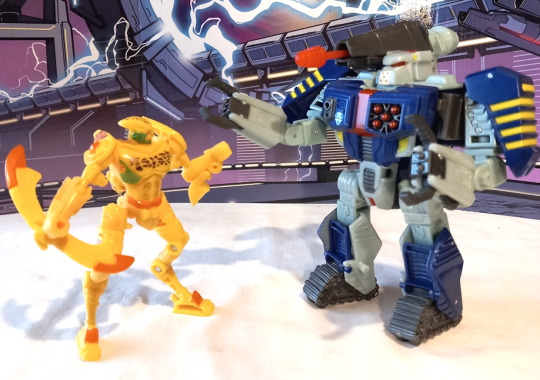
Buone anche le articolazioni, con balljoint su spalle, gomiti ed anche, testa e cosce che ruotano e doppio snodo sulle gambe; peccato sia assente la possibilità di ruotare il bacino, per via della trasformazione, ma almeno si ritrova le sue due classiche scimitarre, fedeli pure loro con le punte arancione e con la possibilità di unirsi per le else divenendo un boomergang come visto nel cartone.
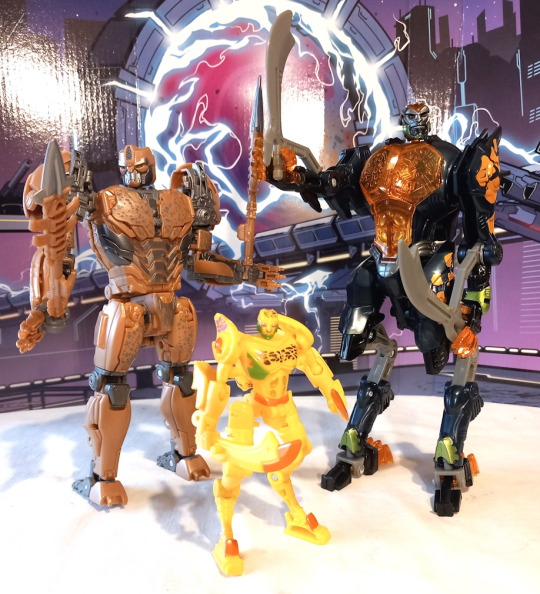
Come per il Night Slash del 2001, le spade trovano posto sulle spalle, sistemazione utile anche per la modalità bestiale, con una TRASFORMAZIONE ovviamente semplice che già lo era nelle versione originali Deluxe e Voyager, con le gambe che accorciano ripiegandosi un po' divenendo le zampe anteriori, mentre per quelle anteriori si ribaltano gli artigli dagli avambraccia coprire i pugni. Il bacino si dispiega un attimo, con la coda che si ribalta dalla schiena, così come la testa felina che va a coprire quella robotica ruotata precedentemente di 180°.
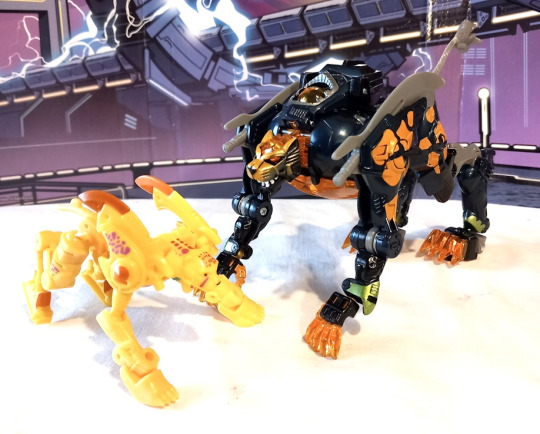
Non si può pretendere troppo da questo piccolo LEOPARDO TECNORGANICO, se già le versioni più grandi faticavano ad assomigliare alla controparte televisiva, quindi apprezziamo i dettagli delle macchie ( anche se giocavano moooooooolto facile sempre per via del solo giallo principale per tutto il modellino ) e le articolazioni delle zampe, anche se tecnicamente spalle ed anche si dovrebbero bloccare attancandosi al corpo tramite appositi perni, ma ciò limita appunto la posabilità, e non è necessario per magari non far collassare a terra la bestia vista la sua piccola statura e quindi leggerezza.
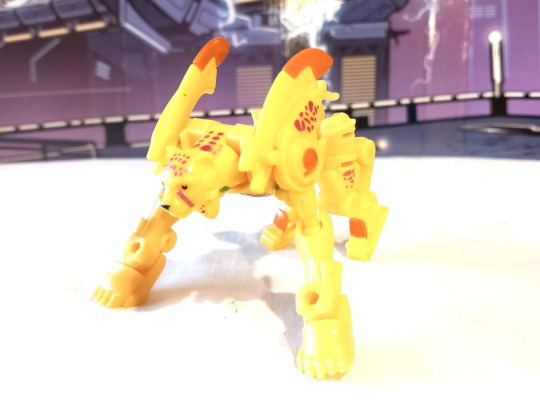
Peccato per la punta della nuca del robot che spunta da sotto il gargarozzo del felino, o la coda piccina, ma, ripeto, il leopardo biomeccanico è quantomeno decente vista la sua classe, quindi nel complesso è un relativo must per i fan del personaggio; più che altro come BM estemporaneo lascerebbe il tempo che trova, non fosse per il discorso della scala coi Tf G1neschi, e quindi sarebbe il caso di allargare il campo dei BW Core class, o comunque ripescare i vari Maximal e Vehicon della serie del 2000 e proporli adeguatamente fra Deluxe e Voyager, sopratutto per via delle disuguaglianze fra giocattoli e personaggi in CGI che ai tempi minò la bistratta Beast Machine. Incrociamo le dita per il futuro, quindi e intanto godiamoci come possiamo questo antipasto! ^^'
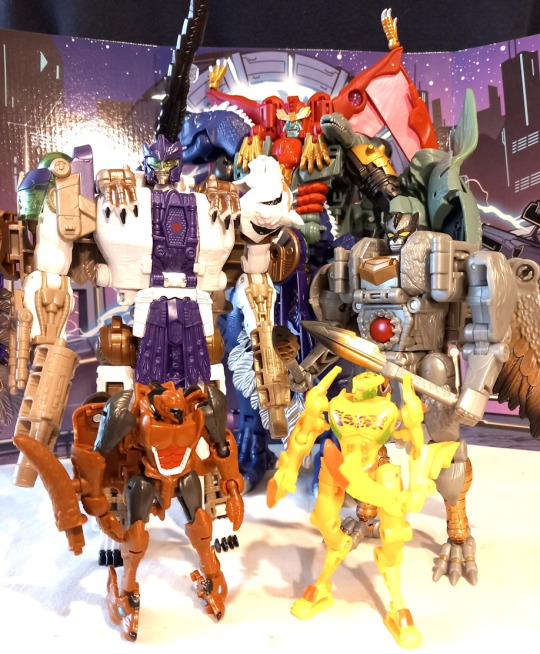
#transformers#hasbro#generations#beastwars#recensione#review#cheetor#beast machines#core#ghepard#biocombat#legacy#united#maximal
0 notes
Text
WHEELJACK *ORIGIN* ( Voyager ) Generations LEGACY UNITED *G1*

E con questo WHEELJACK Origins si può dire che si chiude il capitolo di quel pugno di Transformers apparso nel primissimo episodio dei cartoni G1 esibendo delle modalità alternative Cybertroniane, dopo i precedenti Bumblebee e Jazz Origins da una parte ed i Decepticon Seeker e Soundwave visti in WfC Siege dall'altra ( salvo che magari poi per sfizio non vanno a rifare pure questi, vai a sapere! ).
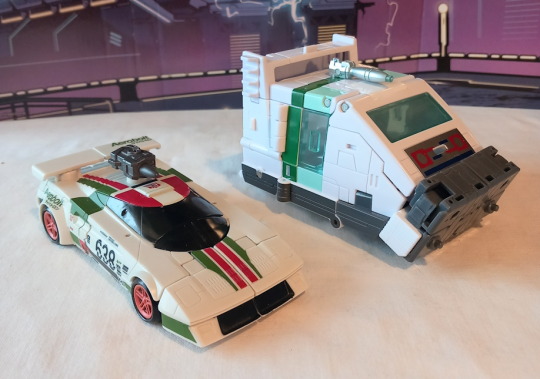
Forse non è un caso che Saetta sia l'ultimo, dato che la sua modalità nativa era probabilmente quella più complicata da realizzare, ovvero una sorta di FURGONCINO hovercraft effettivamente poco attinente con l'alt mode di auto sportiva che assumerà poi sul nostro pianeta, ovvero la celeberrima Lancia Stratos Turbo.
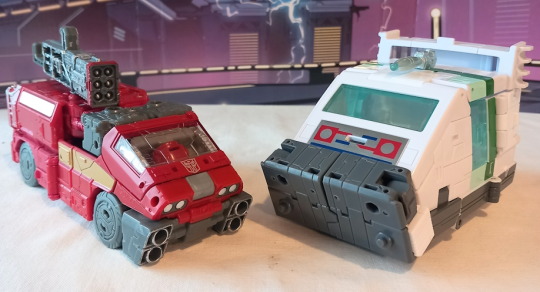
Col senno di poi, forse sarebbe stato più consono mettere un Ironhide al suo posto, nell'iconica scena iniziale dove carica su Maggiolino, ma rimpianti a parte, il veicolo si presenta davvero bene e fedele a com'era nei cartoni, forte anche della sua classe di Voyager, che magari inizialmente può sembra esagerata, ma a conti fatti è stata decisamente necessaria.
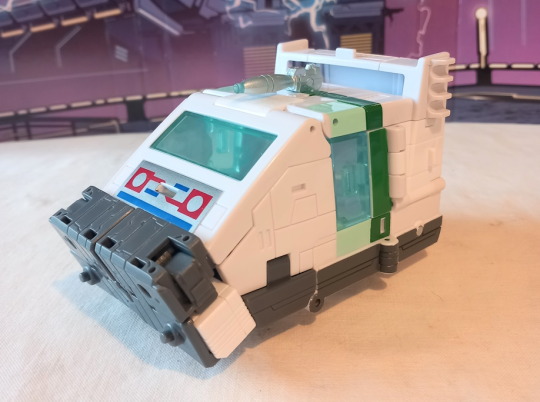
Il veicolo infatti è bello grosso ed è nella media di un Voyager, così come aiutano a rimpinguare la massa i vari accessori, nella forma di una pistola laser da montare sul tettuccio ( che diverrà poi l'iconico cannone da spalla del robot ), più un paio di eliche da sistemare frontalmente a ricreare quanto visto nella sua breve apparizione iniziale, dove faceva uscire dal muso questi rotori per sbaragliare un "posto di blocco" Decepticon.
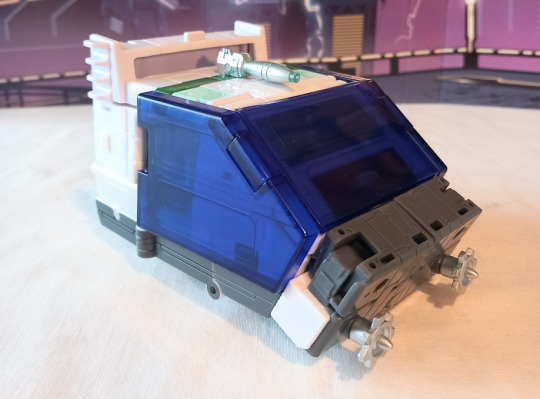
E sempre come visto nel cartone, è possibile applicare un'apposito pannello a 3 pieghevole che simula la modalità blindata che il veicolo assume ad un certo punto della sua fuga dai Seeker: staccando e ricombinando i pannelli esterni questa diventa inoltre una sorta di pista, come le strade che i nostri due Autobot attraversano per le vie di Cybertron! Magari è un po' forzato quest'ultima cosa, ma è un modo come un altro per "trasformare" quei 3 pannelli che non solo nel succitato scudo.
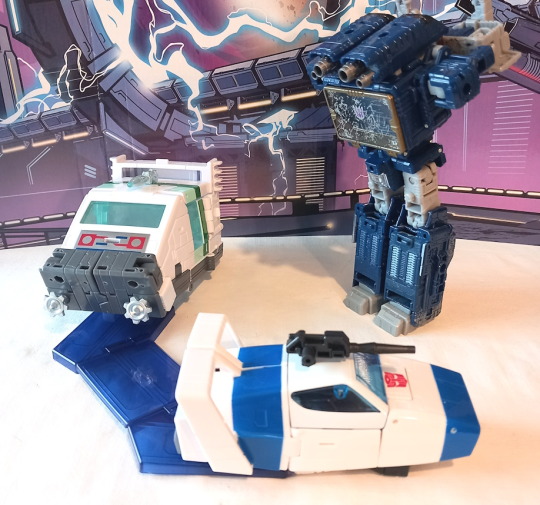
Ma la gimmick principale che giustifica la classe Voyager di questo Saetta è sopratutto quella di poter aprire il portellone posteriore e contenere così la modalità veicolare di Bumblebee Origins ( con le estremità debitamente ripiegate ) sempre come si vede in quell'iconica sequenza!
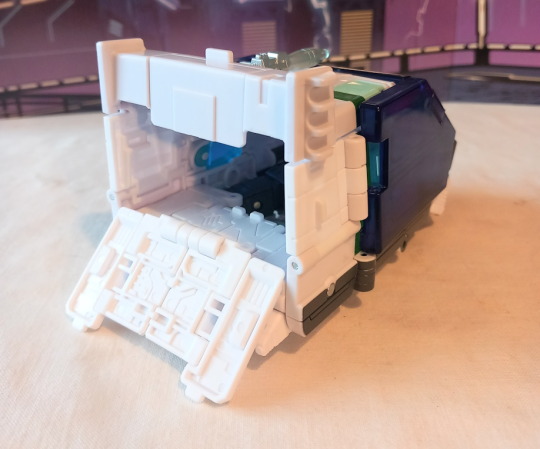
Detto ciò, il veicolo non è che sia FEDELISSIMISSIMO a quello del cartone, a dire il vero: se da una parte abbiamo il bel tocco delle finestre laterali verticali in plastica trasparente, a dover spaccare il capello in quattro il parabrezza è un semplice rettangolo e non si estende verso i lati ( anche se in un'inquadratura dall'alto del cartone si vede così… ), così come l'alettone posteriore è chiuso posteriormente e non si allarga anche lui verso le pareti laterali, come ad esempio anche nel veicolo di Jazz Origins. In compenso, sempre per legarlo al modello di Bee, ai lati dell'alettone ci sono delle scalette apposite per potervi sistemare le barre di Energon che erano allegate al modello di Maggiolino Origins. ^^

Anche la TRASFORMAZIONE omaggia le mitiche primissime sequenze del cartone, dato che il muso del veicolo si divide in due e diventa le braccia del robot, diversamente dalla trasformazione iconica del WJ terrestre, ma appunto mimando ciò che si vedeva in tv. Il resto del veicolo invece vede dispiegarsi i pannelli laterali e posteriori che in maniera egregia finiscono ripiegati nelle gambe, mentre parabrezza e tettuccio semplicemente si ripiegano sulla schiena.

Ricordando che la bizzarria di quei pochi Cybertroniani che nei primi 5 minuti del primo episodio si trasformavano era proprio quella di avere i ROBOT con sui corpi i dettagli dei veicoli terrestri a venire, anche Wheeljack frontalmente è una bella resa del settei G1, ma ovviamente oberato da delle gambone e da un zainone non indifferente, come accennato sopra.

Certo, riesce a mantenere dettagli fondamentali come le alette sulla schiena, così come il cannone si posiziona sulla spalla destra ( e solo quella, però, che solo lì c'è il foro, mah! ), ed è più fedele come forma rispetto all'Earthrise, ed anche il parabrezza sul torso, con la scusa che è farlocco, è più fedele che non quello squadrato sempre dell'ER. Peccato per l'assenza delle strisce verdi sugli stinchi, ed ironicamente è un millimetro più piccolo del Deluxe Generations precedente, nonostante sia un Voyager, ma appunto sappiamo dove va il grosso della massa…

Però è snodato al meglio come Generations, con tanto di rotazione dei polsi, e riesce ad avere qualche foro per armi ai lati di gambe ed avambracci, oltre ai classici sotto i piedi e dietro la schiena / zainone: qui inoltre trovano posto a riposo le elichette di qui sopra ( che volendo possono sistemarsi sulla punta del cannone ), così come la copertura blindata, che aperta e con i pannelli esterni diagonali diventa… un bel paio di ali aggiuntive! ^^'

Vabbè, perlomeno in qualche maniera non vanno persi sti accessori, ecco, e così tozzo questo Saetta sembra ancor più piccolo di quel che è, ma abbiamo già detto che il meglio di se' e la sua ragion d'essere è la modalità veicolare, anche se il robot è indubbiamente fatto al meglio di quel che si possa riuscire.

Insomma, assodato che la sua mancanza di grazia robotica è dovuta all'ingombrante alt mode, e che questo rispecchia al meglio quanto visto in tv, in definitiva è un must per i fan della primissima apparizione di Wheeljack e di quei Tf in generale, un omaggio doveroso che accettiamo volentieri nei limiti del suo design originale.

#transformers#hasbro#generations#autobot#autorobot#recensione#review#voyager#saetta#wheeljack#origins#cybertron#legacy#united#more than meets the eye
1 note
·
View note